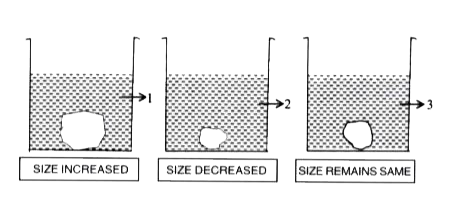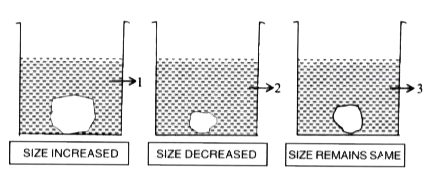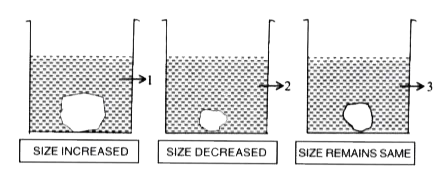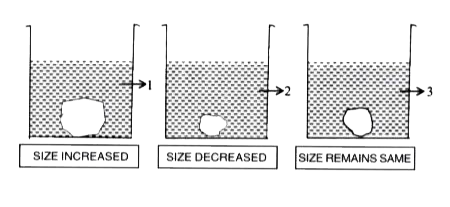In thistle funnel experiment, if sugar is added to beaker after the stoppage f osmosis, then
Level of solution in beaker lowers
Level of solution in thishtle funnel rises up
Level of solution remins unaffected in beaker
Level of solution in thistle funnel lowers.
The correct Answer is:D
Step-by-Step Solution:
1. Understanding the Thistle Funnel Experiment:
- The thistle funnel is filled with a sucrose solution and is placed in a beaker containing pure water. The mouth of the funnel is covered with a semi-permeable membrane (like parchment paper), which allows water to pass through but not the sucrose.
2. Initial Observation:
- Initially, when the experiment starts, water from the beaker moves into the thistle funnel through osmosis, causing the level of the sucrose solution in the funnel to rise. This occurs because water moves from an area of higher water concentration (the beaker) to an area of lower water concentration (the sucrose solution).
3. Stoppage of Osmosis:
- Osmosis will stop when the concentration of the sucrose solution in the funnel equals the concentration of water in the beaker. At this point, there is no net movement of water.
4. Adding Sugar to the Beaker:
- If sugar is added to the beaker after osmosis has stopped, the concentration of solute (sugar) in the beaker increases. This means the concentration of water in the beaker decreases compared to the concentration in the thistle funnel.
5. Effect of Increased Sugar Concentration:
- Due to the increase in sugar concentration in the beaker, water will now move from the thistle funnel (where the concentration of water is higher) to the beaker (where the concentration of water is lower). This process is called exosmosis.
6. Resulting Changes:
- As water moves out of the thistle funnel, the level of the solution in the thistle funnel will decrease. Conversely, the level of the solution in the beaker will increase as more water enters it.
7. Conclusion:
- Therefore, the correct answer to the question is that the level of solution in the thistle funnel lowers.
Final Answer:
The correct option is that the level of solution in the thistle funnel lowers.
---
- The thistle funnel is filled with a sucrose solution and is placed in a beaker containing pure water. The mouth of the funnel is covered with a semi-permeable membrane (like parchment paper), which allows water to pass through but not the sucrose.
- Initially, when the experiment starts, water from the beaker moves into the thistle funnel through osmosis, causing the level of the sucrose solution in the funnel to rise. This occurs because water moves from an area of higher water concentration (the beaker) to an area of lower water concentration (the sucrose solution).
- Osmosis will stop when the concentration of the sucrose solution in the funnel equals the concentration of water in the beaker. At this point, there is no net movement of water.
- If sugar is added to the beaker after osmosis has stopped, the concentration of solute (sugar) in the beaker increases. This means the concentration of water in the beaker decreases compared to the concentration in the thistle funnel.
- Due to the increase in sugar concentration in the beaker, water will now move from the thistle funnel (where the concentration of water is higher) to the beaker (where the concentration of water is lower). This process is called exosmosis.
- As water moves out of the thistle funnel, the level of the solution in the thistle funnel will decrease. Conversely, the level of the solution in the beaker will increase as more water enters it.
- Therefore, the correct answer to the question is that the level of solution in the thistle funnel lowers.
The correct option is that the level of solution in the thistle funnel lowers.
Topper's Solved these Questions
- TRANSPORT IN PLANTSBook:DINESH PUBLICATION ENGLISHChapter:TRANSPORT IN PLANTSExercise:CHECK YOUR GRASP
Explore 40 Videos
- TRANSPORT IN PLANTSBook:DINESH PUBLICATION ENGLISHChapter:TRANSPORT IN PLANTSExercise:CHECK YOUR GRASP
Explore 40 Videos
- THE LIVING WORLDBook:DINESH PUBLICATION ENGLISHChapter:THE LIVING WORLDExercise:Check your grasp
Explore 12 Videos
- VERTEBRATA-AGNATHA AND PISCESBook:DINESH PUBLICATION ENGLISHChapter:VERTEBRATA-AGNATHA AND PISCESExercise:Check Your Grasp
Explore 12 Videos
Similar Questions
In thistle funnel experiment, entry of water into thistle funnel stops after some time autumatically due to
View SolutionA candidate in order to study the process of osmosis has taken 3 potato cubes and put them in 3 different beakers containing 3 different solutions. After 24 hours, in the first beaker, the potato cube increased in size, in the second beaker, the potato cube decreased in size and in the third beaker there was no change in the size of the potato cube. The following diagram shows the result of the same experiment :

In beaker 3, the size of the potato cube remains the same. Explain the reason in brief.
View Solution
Knowledge Check
An unknown liquid collected from a sample of peas, is added to a beaker of water and is vigorously shaken. After few minutes, water and the unknown liquid made two separate layers. To which class of biomolecules, does the unknown liquid most likely belongs ?
ApolysaccharidesBProteinsClipidsDEnzymes
The reaction An+CuSO4→ZnSO4 goes completely to the right. In an experiment, 10.0 g of Zn was added to 200 " mL of " CuSO4 solution. After all the Cu was precipitated, it was found that not all the Zn had dissolved. After filtration, the total weight of the solid at the end of the reaction was 9.810 g. Calculate.
(a). The weight of copper deposited and,
(b). Molarity of CuSO4 in the original solution.
View SolutionAt equilibrium in thistle funnel experiment
View SolutionA candidate in order to study the process of osmosis has taken 3 potato cubes and put them in 3 different beakers containing 3 different solutions. After 24 hours, in the first beaker, the potato cube increased in size, in the second beaker, the potato cube decreased in size and in the third beaker there was no change in the size of the potato cube. The following diagram shows the result of the same experiment :

What is osmosis ?
View SolutionA candidate in order to study the process of osmosis has taken 3 potato cubes and put them in 3 different beakers containing 3 different solutions. After 24 hours, in the first beaker, the potato cube increased in size, in the second beaker, the potato cube decreased in size and in the third beaker there was no change in the size of the potato cube. The following diagram shows the result of the same experiment :

Give the technical terms of the solutions used in beakers, 1 , 2 and 3 .
View SolutionA candidate in order to study the process of osmosis has taken 3 potato cubes and put them in 3 different beakers containing 3 different solutions. After 24 hours, in the first beaker, the potato cube increased in size, in the second beaker, the potato cube decreased in size and in the third beaker there was no change in the size of the potato cube. The following diagram shows the result of the same experiment :

Write the specific feature of the cell sap of root hairs which helps in absorption of water.
View SolutionA candidate in order to study the process of osmosis has taken 3 potato cubes and put them in 3 different beakers containing 3 different solutions. After 24 hours, in the first beaker, the potato cube increased in size, in the second beaker, the potato cube decreased in size and in the third beaker there was no change in the size of the potato cube. The following diagram shows the result of the same experiment :

How does a cell wall and a cell membrane differ in their permeability?
View SolutionWhen 100mL of 1.0MHCl was mixed with 100mL of 1.0MNaOH in an insulated beaker at constant pressure, a temperature increase of 5.7∘C was measured for the beaker and its contents (Expt.1). Because the enthalpy of neutralisation of a strong acid with a strong base is constant (−57.0kJmol−1) this experiment couldbe used to measure the calorimeter constant. In a second experiment (Expt.2), 100mL of 2.0M acetic acid Ka=2.0×10−5) was mixed with 100mL of 1.0MNaOH (under identical conditions to Expt. 1) where a temperature rise of 5.6∘C was measured.
pH of the solution after Expt. 2 is
View Solution